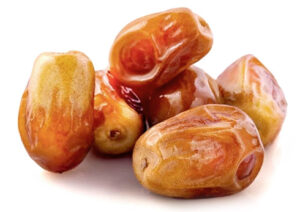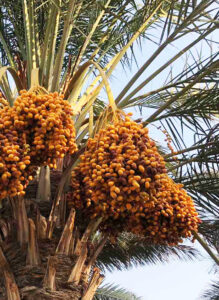Zahedi date is a type of date fruit that is known for its distinctive sweet taste and chewy texture. It is also known as "Qasab" or "Qasbi" date and is one of the most widely grown varieties of date in Iran.
Here are some key characteristics of Zahedi date:
- Appearance: Zahedi dates are small to medium-sized, with an oval shape and a light brown to golden color. The skin of the fruit is thin and slightly wrinkled, while the flesh is firm and chewy.
- Taste: Zahedi dates are known for their sweet flavor, which is often described as caramel-like or honey-like. They also have a slightly nutty taste and a chewy texture.
- Nutritional value: Zahedi dates are a good source of fiber, potassium, and antioxidants. They also contain small amounts of other nutrients such as calcium, iron, and vitamin C.
- Culinary uses: Zahedi dates are often eaten as a snack or used in baking and cooking. They can be chopped and added to salads, used as a sweetener in sauces and marinades, or stuffed with nuts and other fillings.
- Shelf life: Zahedi dates have a relatively long shelf life compared to other varieties of date. When stored in a cool, dry place, they can last for several months without spoiling.
Overall, Zahedi date is a popular variety of date fruit that is widely grown and consumed in Iran and other parts of the world. Its sweet taste, chewy texture, and nutritional value make it a popular snack and ingredient in a variety of dishes.
The Geography of Zahedi Dates
Zahedi dates are primarily grown in Iran, which is one of the largest producers of dates in the world. Specifically, Zahedi dates are mainly grown in the Kerman province in southeastern Iran, which is known for its hot and dry climate that is ideal for date cultivation.
The Kerman province is located in the central part of Iran and is surrounded by several mountain ranges, including the Zagros Mountains to the west and the Kuh-e Banan Mountains to the east. The region has a hot and arid climate, with temperatures often exceeding 40 degrees Celsius in the summer months.
Within the Kerman province, the city of Bam is particularly famous for its Zahedi dates, which are known for their high quality and sweet taste. Bam is located in the southeast of the province, near the border with Afghanistan, and has a long history of date cultivation dating back to ancient times.
In addition to Iran, Zahedi dates are also grown in other countries in the Middle East and North Africa, including Iraq, Saudi Arabia, and Egypt. However, Iranian Zahedi dates are generally considered to be of the highest quality and are wide
Properties of Zahedi Dates
Zahedi dates, also known as Qasab or Qasbi dates, are a type of date fruit that is primarily grown in Iran. They are a popular variety of dates due to their sweet taste, chewy texture, and nutritional properties. Here are some of the key properties of Zahedi dates:
1. Appearance: Zahedi dates are small to medium-sized and have an oval shape. They have a light brown to golden color and a slightly wrinkled skin. The flesh is firm and chewy.
2. Taste: Zahedi dates are known for their sweet, caramel-like flavor, which is less intense than other varieties of dates. They have a slightly nutty taste and a chewy texture.
3. Nutritional value: Zahedi dates are a good source of fiber, potassium, and antioxidants. They also contain small amounts of other nutrients such as calcium, iron, and vitamin C.
4. Health benefits: Zahedi dates offer a range of health benefits due to their high nutrient content. They can help to improve digestive health, boost energy levels, and promote heart health. They are also a good source of antioxidants, which can help to protect against cellular damage and reduce the risk of chronic diseases.
5. Culinary uses: Zahedi dates are often eaten as a snack or used in baking and cooking. They can be chopped and added to salads, used as a sweetener in sauces and marinades, or stuffed with nuts and other fillings.
6. Shelf life: Zahedi dates have a relatively long shelf life compared to other varieties of date. When stored in a cool, dry place, they can last for several months without spoiling.
Overall, Zahedi dates are a popular and widely consumed variety of date fruit that offer a range of health benefits and culinary uses. They are a delicious and nutritious snack that can be enjoyed in a variety of ways.
Zahedi dates offer a range of health benefits due to their high nutrient content. Here are some of the potential health benefits of consuming Zahedi dates:
1. Rich in fiber: Zahedi dates are a good source of dietary fiber, which can help to promote digestive health and prevent constipation.
2. High in potassium: Zahedi dates are also a good source of potassium, which is important for maintaining healthy blood pressure and heart function.
3. Antioxidant properties: Zahedi dates contain a range of antioxidants, including phenolic compounds and carotenoids, which can help to protect against cellular damage and reduce the risk of chronic diseases such as cancer and heart disease.
4. Anti-inflammatory effects: Some studies have suggested that the antioxidants in Zahedi dates may have anti-inflammatory effects, which can help to reduce the risk of chronic inflammation and related conditions such as arthritis and diabetes.
5. May improve bone health: Zahedi dates are a good source of calcium and other minerals that are important for maintaining healthy bones and preventing osteoporosis.
6. May improve brain function: Some studies have suggested that the antioxidants in Zahedi dates may have neuroprotective effects, which can help to improve cognitive function and reduce the risk of age-related cognitive decline.
Overall, consuming Zahedi dates as part of a balanced diet can provide a range of health benefits due to their high nutrient content and antioxidant properties. However, it is important to consume them in moderation as they are also high in calories and sugar.
Harvesting Season of Zahedi Dates
The harvesting season of Zahedi dates typically begins in late summer or early fall, depending on the climate and growing conditions in the region where they are grown. In Iran, which is one of the largest producers of Zahedi dates, the harvesting season usually starts in late August or early September and lasts for several weeks.
During the harvesting season, the date palm trees are carefully climbed by skilled workers who use ladders, ropes, and other tools to reach the ripe fruit. The dates are then carefully plucked from the branches and placed in baskets or other containers for transport.
After the dates are harvested, they are usually washed, sorted, and dried in the sun for several days to remove excess moisture and improve their flavor and texture. They are then packaged and shipped to markets and consumers around the world.
The exact timing of the harvesting season for Zahedi dates can vary depending on factors such as climate, soil conditions, and other environmental factors. However, in general, the harvesting season for Zahedi dates takes place in late summer or early fall and is an important time for date farmers and workers in the regions where they are grown.
Sorting of Zahedi Dates
Sorting of Zahedi dates is an important process that takes place after the dates are harvested and before they are packaged for sale or export. The sorting process helps to ensure that the dates are of high quality and free from defects or impurities.
The sorting process typically involves several steps, including:
1. Washing: The dates are first washed to remove any dirt, dust, or debris that may have accumulated during the harvesting process.
2. Inspection: The dates are then inspected by trained workers who carefully examine them for any signs of damage, such as cracks, splits, or insect infestations. Any dates that are found to be damaged or defective are removed from the batch.
3. Grading: Once the dates have been inspected, they are graded according to their size, color, and other characteristics. This helps to ensure that the dates are consistent in quality and appearance.
The sorting process is important for ensuring that Zahedi dates are of high quality and meet the standards of consumers and buyers. It helps to ensure that the dates are free from defects or impurities and are consistent in size, color, and flavor. By ensuring that the dates are of high quality, the sorting process helps to maintain the reputation of Zahedi dates as a premium variety of date fruit.
Packaging of Zahedi Dates
Packaging of Zahedi dates is an important step in the process of preparing them for market. Zahedi dates are a popular variety of date fruit that are valued for their sweet taste, chewy texture, and nutritional properties. Here are some of the key aspects of packaging Zahedi dates:
1. Material: Zahedi dates are typically packaged in materials that help to protect them from damage and spoilage during transport and storage. Common packaging materials include cardboard boxes, plastic bags, and vacuum-sealed containers.
2. Size: Zahedi dates are typically packaged in different sizes, depending on the preferences of consumers and buyers. They may be packaged in small bags or containers for individual sale, or in larger bulk quantities for commercial buyers.
3. Labeling: Zahedi dates are often labeled with information about their origin, production methods, and nutritional properties. This helps to inform consumers and buyers about the quality and characteristics of the dates.
4. Storage: Zahedi dates should be stored in a cool, dry place to prevent spoilage and maintain their quality. Proper storage is important for ensuring that the dates remain fresh and flavorful for as long as possible.
Overall, packaging is an important aspect of preparing Zahedi dates for market. Proper packaging helps to protect the dates from damage and spoilage, maintain their quality, and inform consumers and buyers about their characteristics and nutritional properties. By ensuring that Zahedi dates are properly packaged, growers and exporters can help to maintain the reputation of this popular variety of date fruit.
Transporting of Zahedi Dates
Transporting of Zahedi dates is an important aspect of the process of getting the dates from the farm to the consumer. Zahedi dates are a popular variety of date fruit that are grown in many regions around the world, including Iran, which is one of the largest producers of Zahedi dates. Here are some of the key aspects of transporting Zahedi dates:
1. Mode of transport: Zahedi dates can be transported by air, sea, or land, depending on the distance and location of the destination. Air transport is the fastest option and is often used for long-distance transport to overseas markets. Sea transport is slower but can be more cost-effective for large quantities of dates. Land transport is often used for short distances or for transport within the same country.
2. Packaging: Zahedi dates need to be packaged properly for transport to protect them from damage and spoilage. Common packaging materials include cardboard boxes, plastic bags, and vacuum-sealed containers.
3. Temperature control: Zahedi dates are sensitive to temperature and humidity, and must be transported in a cool, dry environment to prevent spoilage. Temperature-controlled containers or refrigerated trucks are often used to maintain the quality of the dates during transport.
4. Handling: Zahedi dates must be handled carefully during transport to prevent damage to the fruit. They should be loaded and unloaded gently, and should not be stacked too high to avoid crushing or bruising.
5. Regulations: Depending on the destination, there may be regulations or customs requirements that must be met for the transport of Zahedi dates. Growers and exporters must ensure that all necessary permits and paperwork are in order before shipping the dates.
Overall, transporting Zahedi dates requires careful planning and attention to detail to ensure that the dates arrive at their destination in good condition. Proper packaging, temperature control, handling, and compliance with regulations are all important aspects of transporting Zahedi dates. By ensuring that the dates are transported safely and efficiently, growers and exporters can help to maintain the reputation of this popular variety of date fruit.

